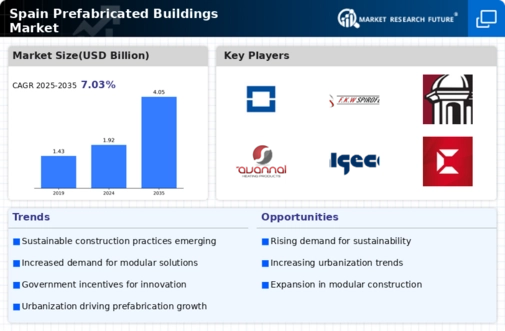Rising Urbanization
The increasing urbanization in Spain is a pivotal driver for the prefabricated buildings market. As more individuals migrate to urban areas, the demand for housing and commercial spaces intensifies. Prefabricated buildings offer a rapid solution to this growing need, allowing for quicker construction times and reduced labor costs. In 2025, urban areas in Spain are projected to house over 80% of the population, necessitating innovative building solutions. The prefabricated buildings market will benefit from this trend, as these structures can be efficiently deployed in densely populated regions. Furthermore, the ability to customize prefabricated units to meet specific urban requirements enhances their appeal, making them a preferred choice for developers and city planners alike.
Technological Integration
Technological advancements are reshaping the prefabricated buildings market in Spain. Innovations in design software, manufacturing processes, and construction techniques are enhancing the efficiency and quality of prefabricated structures. The integration of Building Information Modeling (BIM) allows for precise planning and execution, minimizing errors and delays. In 2025, it is expected that the use of advanced robotics and automation in the production of prefabricated components will further streamline operations. This technological evolution not only improves the speed of construction but also elevates the overall quality of the final product. As a result, stakeholders in the prefabricated buildings market are likely to embrace these advancements to remain competitive and meet the growing demands of consumers.
Environmental Sustainability
The growing emphasis on environmental sustainability is a crucial driver for the prefabricated buildings market in Spain. As awareness of climate change and resource depletion increases, there is a strong push for eco-friendly construction practices. Prefabricated buildings often utilize sustainable materials and energy-efficient designs, aligning with the preferences of environmentally conscious consumers. In 2025, it is projected that the market for sustainable building materials will expand significantly, with prefabricated solutions playing a central role. This trend is likely to attract investments and partnerships focused on green building initiatives, further bolstering the prefabricated buildings market. The alignment of these structures with sustainability goals positions them as a viable option for future construction projects.
Cost-Effective Construction Solutions
The need for cost-effective construction solutions is a significant driver for the prefabricated buildings market in Spain. With rising construction costs, developers are increasingly turning to prefabricated options to mitigate expenses. These buildings can be produced in a controlled environment, reducing material waste and labor costs. In 2025, the average cost savings associated with prefabricated construction is estimated to be around 20-30% compared to traditional methods. This financial advantage makes prefabricated buildings an attractive option for both residential and commercial projects. As the market continues to evolve, the emphasis on affordability is likely to propel the adoption of prefabricated solutions, particularly in economically sensitive regions.
Government Initiatives and Regulations
Government policies in Spain are increasingly favoring the adoption of prefabricated buildings. Initiatives aimed at promoting sustainable construction practices and reducing carbon footprints are driving the market forward. The Spanish government has set ambitious targets for reducing greenhouse gas emissions, which aligns with the benefits of prefabricated buildings. These structures typically generate less waste and utilize materials more efficiently. In 2025, it is anticipated that government incentives will further encourage the use of prefabricated solutions in public infrastructure projects. This regulatory support is likely to create a favorable environment for the prefabricated buildings market, as stakeholders seek to comply with evolving standards and capitalize on available funding.

















Leave a Comment